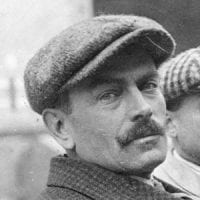A top-line racing driver for 28 years, Louis Wagner was never the star of the field but twice won major Grands Prix. He also holds the distinction of winning the inaugural GPs held in America and in England. With his serious expression and piercing blue eyes, a sense of fair play was paramount for this Frenchman.
Motor racing pioneer
The teenage Wagner started racing for Darracq in 1903 with success in voiturettes. He was running third in class in that year’s ill-fated Paris-Madrid when it was stopped at Bordeaux and he then won the Circuit des Ardennes des Voiturettes – a success he repeated in 1905.
He retired from the very first GP – the 1906 GP de l’Automobile Club de France at Le Mans – but enjoyed success in America at the end of the year. The W.K.Vanderbilt Cup was marred by poor crowd control but Wagner’s Darracq led all the way to victory despite a late tyre change.
Grand Prix winner for Fiat
Wagner left Darracq after being criticised following his retirement from the 1907 Targa Florio and joined Fiat. Fifth in the Kaiserpreis, he ran second in the French GP before retiring that year and the next. Wagner won the inaugural American Grand Prize in 1908 after a close four-way duel on the last 25-mile lap. That was despite his riding mechanic Antonio Ferro having to hold a temporary oil tank between his knees for the last 100 miles.
Second in the 1912 French GP with a Fiat S74, Wagner’s racing activities were curtailed by his aviation career as chief test pilot for the company formed by fellow racing driver René Hanriot. He did return with Mercedes in the 1914 French GP and again finished second, this time behind team-mate Christian Lautenschlager.
Post-war racing career
Wagner served in the French artillery during World War I before resuming his racing career in 1919 when he retired a Ballot from the Indianapolis 500. He returned to GP racing in 1921 when seventh in France for Ballot and third in Italy on a one-off reprise with Fiat.
His 1922 season with Rolland-Pilain was a disappointment and Wagner joined Alfa Romeo for 1924. The year began with Wagner finishing ninth on the Targa Florio despite his car hitting a policeman during the race. The team dominated GP racing. Wagner came fourth in France and second in Italy.
Sixth on his Le Mans debut for Ariès in 1925, he finished second on the Targa Florio for Peugeot and French GP when sharing a Delage with Paul Torchy in that latter race. He remained with Delage for 1926 and finished third in the Spanish GP sharing with young star Robert Benoist.
A GP was organised in Britain for the first time that year. Wagner’s Delage 15S8 retired after just six laps at Brooklands but he took over Robert Sénéchal’s second placed car at three-quarter distance. Benoist’s leading Delage was delayed in the pits and Sénéchal/Wagner won the gruelling four-hour marathon by 10 minutes. At 44 years, six months and two days old, Wagner is the seventh oldest GP winner in history.
The 1927 French GP was his final such race and he competed for the last time in the 1929 Targa Florio. His left leg was amputated in 1944 after an infection and Wagner later worked as the assistant circuit manager at Montlhéry. He was awarded the Légion d’Honneur in 1955 but died a poor man five years later after a long illness.


